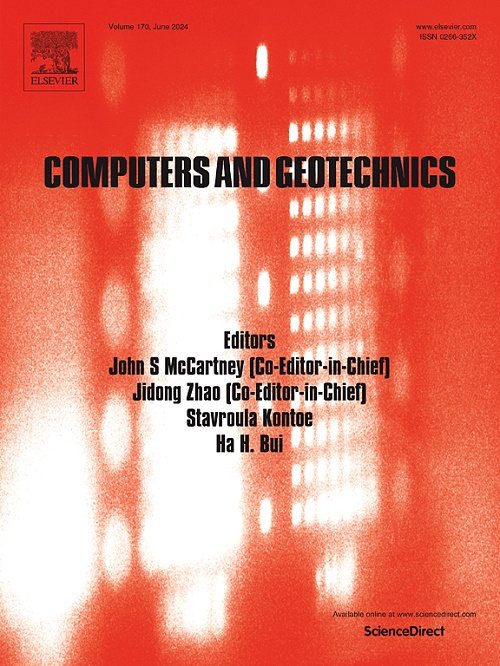Experimental and numerical investigation of cyclic behavior in single-helix anchors embedded in clay under vertical uplift loading
IF 5.3
1区 工程技术
Q1 COMPUTER SCIENCE, INTERDISCIPLINARY APPLICATIONS
引用次数: 0
Abstract
This study investigates the cyclic behavior of single-helix anchors embedded in clay to address the expanding use of helical anchors in transmission tower foundations and submerged pipelines within clay. Laboratory model tests were conducted to assess the effect of the helical anchor configurations on the ultimate uplift capacity, specifically examining the influences from the anchor shaft diameter and helix plate embedment depth. Additionally, this study evaluated the effects of mean load, cyclic load amplitude, and cyclic number on vertical displacement accumulation. Complementing the laboratory experiments, finite element simulations using elastoplastic bounding surface theory were utilized to model the cyclic response of single-helix anchors. Findings from laboratory and numerical simulations indicated that increasing embedment depth and shaft diameter could improve uplift capacity under monotonic loading and reduce displacement accumulation under cyclic loading. A series of cyclic interaction diagrams were generated through finite element simulations for different helical anchor configurations and cyclic loads. By performing regression analysis with the Randional2D function, the cyclic interaction diagrams were transformed from discrete data points into a continuous map, offering a predictive framework for assessing helical anchor stability under cyclic loading and practical insights into the application of helical anchors.
竖向上拔荷载作用下粘土单螺旋锚杆循环性能试验与数值研究
为了解决螺旋锚在输电塔基础和粘土内淹没管道中的广泛应用,本研究调查了嵌入粘土中的单螺旋锚的循环行为。通过室内模型试验,评估了螺旋锚配置对最终上拔能力的影响,具体考察了锚轴直径和螺旋板嵌入深度的影响。此外,本研究还评估了平均荷载、循环荷载幅值和循环次数对竖向位移累积的影响。在实验室实验的基础上,利用弹塑性边界面理论对单螺旋锚的循环响应进行了有限元模拟。室内试验和数值模拟结果表明,增加埋置深度和井筒直径可以提高单调荷载作用下的隆升能力,减少循环荷载作用下的位移积累。通过有限元模拟,得到了不同螺旋锚构型和循环载荷下的一系列循环相互作用图。通过使用randomal2d函数进行回归分析,循环相互作用图从离散数据点转换为连续图,为评估螺旋锚在循环荷载下的稳定性提供了预测框架,并为螺旋锚的应用提供了实际见解。
本文章由计算机程序翻译,如有差异,请以英文原文为准。
求助全文
约1分钟内获得全文
求助全文
来源期刊

Computers and Geotechnics
地学-地球科学综合
CiteScore
9.10
自引率
15.10%
发文量
438
审稿时长
45 days
期刊介绍:
The use of computers is firmly established in geotechnical engineering and continues to grow rapidly in both engineering practice and academe. The development of advanced numerical techniques and constitutive modeling, in conjunction with rapid developments in computer hardware, enables problems to be tackled that were unthinkable even a few years ago. Computers and Geotechnics provides an up-to-date reference for engineers and researchers engaged in computer aided analysis and research in geotechnical engineering. The journal is intended for an expeditious dissemination of advanced computer applications across a broad range of geotechnical topics. Contributions on advances in numerical algorithms, computer implementation of new constitutive models and probabilistic methods are especially encouraged.
 求助内容:
求助内容: 应助结果提醒方式:
应助结果提醒方式:


